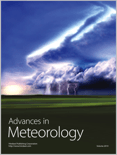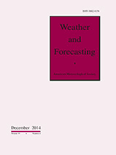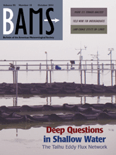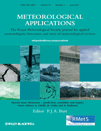
Advances in Meteorology
Scope & Guideline
Pioneering Research for a Changing Climate
Introduction
Aims and Scopes
- Meteorological Phenomena Analysis:
Research on various meteorological phenomena such as tropical cyclones, thunderstorms, and rainfall patterns, focusing on their characteristics, prediction, and impacts. - Climate Change and Variability Studies:
Investigations into the impacts of climate change on weather patterns, agricultural practices, and ecosystem dynamics, emphasizing adaptation and mitigation strategies. - Remote Sensing and Data Assimilation:
Utilization of remote sensing technologies and data assimilation techniques for improving weather forecasts and climate models. - Hydrometeorological Research:
Studies on hydrological processes, including rainfall variability, drought monitoring, and flood risk assessment, to support water resource management. - Statistical and Computational Modeling:
Application of statistical methods and machine learning models in analyzing meteorological data and enhancing prediction accuracy. - Urban Meteorology:
Examination of urban climate phenomena such as the urban heat island effect and air quality, focusing on the interaction between urbanization and meteorological factors.
Trending and Emerging
- Impacts of Climate Change on Agriculture:
Recent publications increasingly address the effects of climate change on agricultural practices and food security, emphasizing the need for adaptive strategies in response to changing climatic conditions. - Urban Climate Resilience:
There is a growing focus on urban meteorology, particularly the study of urban heat islands and air quality, reflecting an increased awareness of the impact of urbanization on local climates. - Advanced Data Analytics in Meteorology:
The use of machine learning and big data analytics to enhance weather prediction models is on the rise, showcasing the journal's commitment to integrating technology into meteorological research. - Cross-Disciplinary Environmental Studies:
Emerging themes include interdisciplinary studies that connect meteorology with environmental science, public health, and urban planning, reflecting a holistic approach to understanding atmospheric phenomena. - Climate Variability and Extreme Weather Events:
There is an increasing emphasis on understanding the relationship between climate variability and the frequency of extreme weather events, which is critical for risk assessment and management.
Declining or Waning
- Traditional Weather Forecasting Techniques:
There seems to be a shift away from conventional weather forecasting methods in favor of advanced machine learning and statistical approaches, indicating a declining interest in traditional techniques. - Localized Studies with Limited Scope:
Research focusing solely on localized meteorological studies without broader implications or connections to global trends appears to be decreasing, as the journal emphasizes more comprehensive and impactful studies. - General Climate Studies:
Broad studies that do not specifically address pressing climate issues or actionable insights are becoming less common, as the journal seeks research that provides concrete solutions to contemporary climate challenges.
Similar Journals

WEATHER AND FORECASTING
Unveiling the Science Behind Weather PredictionsWeather and Forecasting is a premier journal published by the American Meteorological Society, focusing on cutting-edge research in the field of atmospheric science. With its ISSN 0882-8156 and E-ISSN 1520-0434, the journal has distinguished itself within the scientific community, holding a Q1 ranking in Atmospheric Science for 2023 and ranking #56 out of 148 in the Scopus Earth and Planetary Sciences category, demonstrating its influence and high-quality content. Since its inception in 1992, Weather and Forecasting has been dedicated to advancing knowledge in meteorology through rigorous peer-reviewed articles that span a wide range of topics—from numerical weather prediction to climate impacts and atmospheric dynamics. While the journal is not open access, it remains accessible to a broad audience through institutional subscriptions, reinforcing its role as a vital resource for researchers, practitioners, and students alike. With a commitment to excellence in scholarship and a vision towards the future, this journal plays a significant role in shaping the understanding of weather phenomena and forecasting methodologies.

Russian Meteorology and Hydrology
Pioneering discussions in meteorological and hydrological sciences.Russian Meteorology and Hydrology is a distinguished journal published by PLEIADES PUBLISHING INC, specializing in the fields of meteorology and hydrology. With an ISSN of 1068-3739 and an E-ISSN of 1934-8096, this journal has been an authoritative source of research and insights since its inception in 1993. Aiming to disseminate cutting-edge research and foster discussions across related disciplines, it ranks in the Q4 category for Atmospheric Science and Q3 for both Fluid Flow and Transfer Processes as well as Water Science and Technology as of 2023. While currently not an open-access publication, it provides crucial insights essential for researchers, professionals, and students dedicated to understanding the complexities of climate systems and water resources. With its focus on innovative methodologies and comprehensive studies, Russian Meteorology and Hydrology remains a vital platform for advancing knowledge and practice in these critical domains.

Tethys-Journal of Mediterranean Meteorology & Climatology
Illuminating the Complexities of Mediterranean ClimatologyTethys - Journal of Mediterranean Meteorology & Climatology, published by the Associació Catalana de Meteorologia (ACAM), serves as a specialized platform dedicated to advancing the study of meteorological and climatological phenomena within the Mediterranean region. With a Scopus Rank of #94 out of 148 in the field of Atmospheric Science, this journal is positioned in the Q4 category, reflecting a growing recognition among researchers focused on regional climate variations and environmental challenges. Established in 2012 and publishing through 2023, Tethys aims to provide open access to high-quality research articles that address critical issues impacting climate and weather patterns, thus contributing to a deeper understanding of Mediterranean meteorology. The journal’s mission aligns closely with the increasing global emphasis on climate studies and serves as an essential resource for academics, practitioners, and students dedicated to sustainably addressing the environmental and climatic challenges faced by this diverse and dynamic region.

Journal of Tropical Meteorology
Connecting Scholars to Unravel Tropical Meteorological MysteriesJournal of Tropical Meteorology, published by JOURNAL OF TROPICAL METEOROLOGICAL PRESS, is a leading scholarly journal dedicated to advancing the understanding of atmospheric phenomena and meteorological patterns in tropical regions. With an ISSN of 1006-8775, this journal plays a vital role in disseminating high-quality research, focusing on critical issues such as climate variability, weather forecasting, and tropical cyclone dynamics. The journal, which is indexed in Scopus with a respectable rank in the low quartile of Q3 in Atmospheric Science, aims to provide a platform for researchers and professionals to share groundbreaking insights and foster collaboration within the scientific community. Although it follows a traditional access model, the Journal of Tropical Meteorology encourages submissions from a diverse range of disciplines, thus enriching the field with a variety of perspectives. By bridging theory and practical applications, this journal serves as an essential resource for students, researchers, and practitioners striving to expand their knowledge and contribute to the global conversation on meteorology.

TELLUS SERIES A-DYNAMIC METEOROLOGY AND OCEANOGRAPHY
Connecting Oceans and Atmospheres: Where Science Meets InsightTELLUS SERIES A-DYNAMIC METEOROLOGY AND OCEANOGRAPHY, published by Stockholm University Press, is a prestigious open-access journal that has been at the forefront of research in the fields of atmospheric science and oceanography since its inception in 1983. With an enduring commitment to disseminating high-quality, peer-reviewed research, the journal has achieved a commendable impact factor, securing its position in the Q2 category for both Atmospheric Science and Oceanography as of 2023. The journal's significant reach is reflected in its Scopus rankings, being positioned at Rank #51 in Oceanography and Rank #77 in Atmospheric Science. With open access established since 2012, TELLUS SERIES A serves not only as a vital resource for researchers and professionals in these dynamic fields but also as an inclusive platform for budding scholars and students. Engaging with this journal allows readers to stay updated on the latest developments and groundbreaking discoveries that advance our understanding of climate systems and marine environments. Its editorial ethos emphasizes the cross-disciplinary integration of atmospheric and oceanographic studies, making it an essential publication for anyone invested in environmental research and policy.

JOURNAL OF THE METEOROLOGICAL SOCIETY OF JAPAN
Advancing Atmospheric Knowledge Since 1905Journal of the Meteorological Society of Japan, ISSN 0026-1165 (E-ISSN 2186-9057), is a leading academic journal published by the Meteorological Society of Japan, dedicated to advancing the field of atmospheric sciences. Established in 1905, the journal has a long-standing tradition of publishing high-quality research that contributes to our understanding of meteorology, climatology, and environmental science. As an Open Access journal since 2018, it ensures wide dissemination of knowledge, allowing researchers, professionals, and students to access cutting-edge studies without barriers. With an impressive impact factor and ranked in the Q1 category in Atmospheric Science, it is recognized for its significant contributions, currently holding a Scopus rank of #36 out of 148 in the field. The journal serves as a vital resource for those involved in meteorological research, policy-making, and education, fostering collaboration and innovation within and beyond Japan.

Meteorology Hydrology and Water Management-Research and Operational Applications
Advancing knowledge at the intersection of water and weather.Meteorology Hydrology and Water Management - Research and Operational Applications is a prominent academic journal published by the Institute of Meteorology and Water Management, based in Warsaw, Poland. With a focus on advancing the understanding and application of meteorology, hydrology, and water resource management, this journal plays a crucial role in disseminating high-quality research that contributes to both theoretical knowledge and practical applications in these pivotal fields. Although it operates under traditional access options, the journal is dedicated to providing valuable insights and solutions to challenges faced by researchers, practitioners, and policymakers in water management and environmental studies. Researchers keen on exploring innovative methodologies, operational tools, and empirical studies will find this journal an essential resource in enhancing their work and understanding of the dynamic interplay between meteorological phenomena and water resource management. The journal's commitment to maintaining rigorous scholarly standards ensures that every publication drives impactful dialogues within the community and beyond.

ATMOSFERA
Advancing Atmospheric Science for a Sustainable FutureATMOSFERA is a prestigious journal published by CENTRO CIENCIAS ATMOSFERA UNAM, dedicated to advancing the field of Atmospheric Science. With an ISSN of 0187-6236 and an E-ISSN of 2395-8812, this bilingual journal has been a vital resource for researchers since its inception in 1988. Located in Mexico City, the journal serves as a platform for high-quality original research, reviews, and case studies that explore various atmospheric phenomena, climate issues, and environmental challenges. Although currently categorized in the Q4 quartile of Atmospheric Science, ATMOSFERA aims to contribute to the growing body of knowledge in the field and improve its ranking over the next few years, emphasizing rigorous scientific inquiry and fostering collaboration among scholars. Its accessibility and commitment to open communication make it an essential reference for professionals and students striving to understand and address complex atmospheric dynamics.

BULLETIN OF THE AMERICAN METEOROLOGICAL SOCIETY
Pioneering research that shapes our understanding of the skies.BULLETIN OF THE AMERICAN METEOROLOGICAL SOCIETY, published by the American Meteorological Society, stands as a premier forum in the field of meteorology and atmospheric science, boasting an impressive ranking in the Q1 category for 2023. With a long-standing history dating back to 1972, this journal serves as a vital resource for researchers, practitioners, and students dedicated to advancing the understanding of atmospheric phenomena. The journal facilitates the dissemination of cutting-edge research, innovative methodologies, and significant findings that propel the scientific community forward. Although not an Open Access journal, it remains a critical publication for comprehending complex environmental interactions, climate change, and weather-related phenomena. The BULLETIN OF THE AMERICAN METEOROLOGICAL SOCIETY is essential reading for anyone invested in atmospheric sciences, providing invaluable insights that shape policy, enhance safety, and promote environmental sustainability.

METEOROLOGICAL APPLICATIONS
Exploring Innovative Solutions for Atmospheric ChallengesMETEOROLOGICAL APPLICATIONS is an esteemed journal published by WILEY that has been a vital resource in the field of atmospheric science since its inception in 1994. With an Impact Factor indicative of its credibility and influence in the academic community, the journal has notably achieved a Q2 ranking in the 2023 category quartiles for Atmospheric Science, demonstrating its commitment to advancing knowledge in meteorology. As an Open Access journal since 2020, it provides widespread accessibility to researchers, professionals, and students, promoting collaborative efforts in the pursuit of innovative solutions to atmospheric challenges. With its dedicated focus on interdisciplinary studies in meteorology, METEOROLOGICAL APPLICATIONS serves as a crucial platform for sharing cutting-edge research and fostering dialogue among experts, thereby enhancing our understanding of weather phenomena and their global impacts. For submissions and accessing articles, the journal can be found at WILEY’s headquarters in Hoboken, NJ, representing a hub for scholarly discourse in the atmospheric sciences.